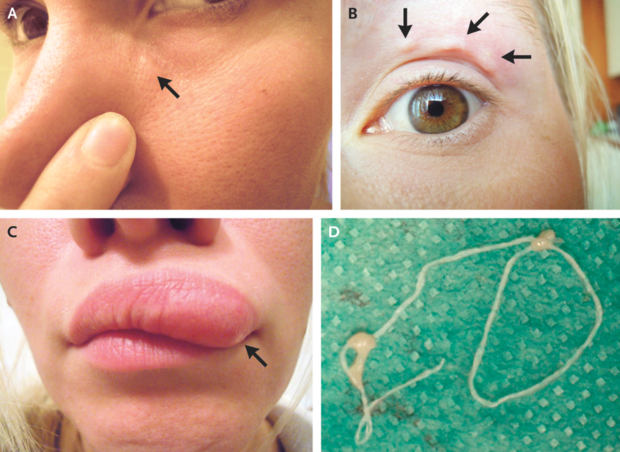Woman's Selfies Capture Parasite Moving Under Her Skin
MOSCOW (CNN) - Through a series of selfies, a woman documented a lump under her skin for weeks before doctors were able to remove it -- and it didn't stay in one place, according to a case report in the New England Journal of Medicine.
The lump appeared after the 32-year-old unnamed woman visited a rural area near Moscow. It was first a tiny bump under her left eye. Five days later, it appeared above the eye. Her upper lip was bulging 10 days after that.
Doctors ultimately gripped the bulge with forceps and, using some local anesthesia, pulled out a parasitic worm known as Dirofilaria repens.
"The parasite can appear and disappear in few minutes," Dr. Vladimir Kartashev, a professor of medicine at Rostov State Medical University who saw the patient, told CNN in an email. "Doctors who are not familiar with the disease don't believe the patients. That's why I asked the patient to make selfies."
But Kartashev had seen "at least 10 patients with the same presentation before," and the migrating form can be "extremely confusing," he said.
The parasitic worm is normally found in dogs and other carnivores, entering the body as a larvae through a mosquito bite, according to the U.S. Centers for Disease Control and Prevention. But humans may become "accidental hosts," the agency explained.
In their adult form, the worms can measure as long as 170 millimeters and live between five and 10 years, according to the CDC. Cases have been reported around the globe, particularly in parts of Europe, Asia and Africa. "Dirofilaria repens is an emerging parasite of the Old World," Kartashev said.
In humans, Dirofilaria repens usually appears as lumps under the skin, but have occasionally been found in the eye. In rarer cases, it has been found elsewhere: the lung, breast or male genitals. In a 2009 case report, one strain of the parasite even caused meningoencephalitis, or inflammation of the brain and its surrounding membranes.
Because the worms typically remain infertile in humans, the cure is usually to remove the parasite through a small incision. In the woman's case, "It took not more than 15 minutes," Kartashev said.
(© Copyright 2018 Cable News Network, Inc., a Time Warner Company. All Rights Reserved. This material may not be published, broadcast, rewritten or redistributed.)




